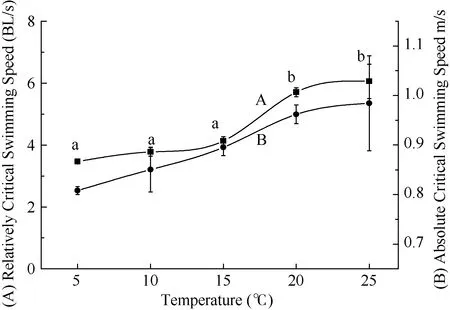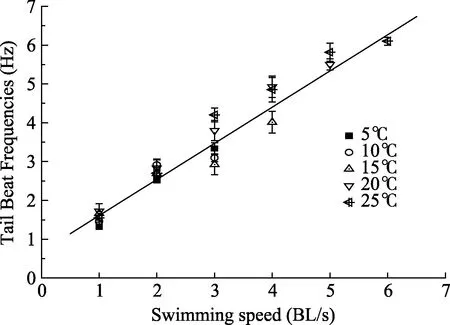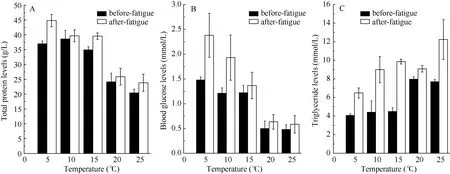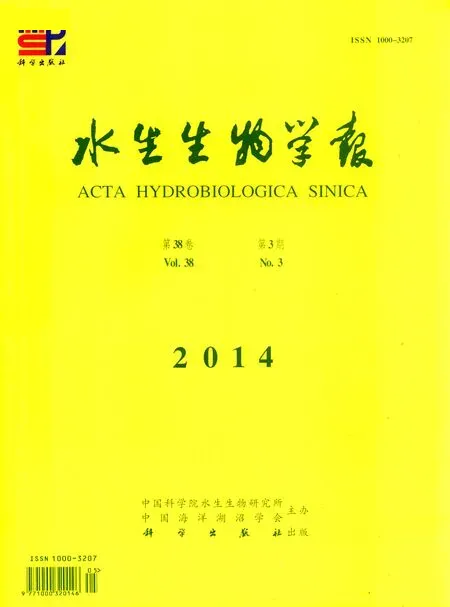THE EFFECT OF TEMPERATURE ON FATIGUE INDUCED CHANGES IN THE PHYSIOLOGY AND SWIMMING ABILITY OF JUVENILE ARISTICHTHYS NOBILIS (BIGHEAD CARP)
YUAN Xi, LI Li-Ping, TU Zhi-Ying, CAI Lu, , David M. Johnson and HUANG Ying-Ping
(1. Collaborative Innovation Center for Geo-Hazards and Eco-Environment in Three Gorges Area, Hubei Province, Yichang 443002,China; 2. Institute of Hydrobiology, Ministry of Water Resources and Chinese Academy of Sciences, Hubei Wuhan 430079, China;3. School of Natural Sciences and Mathematics, Ferrum College, Ferrum, VA 24088, USA)
Abstract: Aristichthys nobilis (bighead carp) is a commercially valuable fish with a natural range extending from southern China to the Amur River. Dams interfere withspawning migrations and reproduction in wild populations has declined and effective fish passages are needed. To obtain data for the design of effective fish passages for A. nobilis, a laboratory study of the swimming ability of juvenile A. nobilis was conducted in a fl ume-type respirometer. Critical swimming speed (Ucrit) was determined at five temperatures (5, 10, 15,20 and 25℃) and Ucrit increased significantly (P<0.05) with increasing temperature, reaching a maximum of 7.01 BL/s (1.19 m/s) at 25℃. The physiological stress caused by swimming to fatigue was assessed by measuring serum levels of total protein (TP), blood glucose (Glu) and triglyceride (TG) before and after fatigue at 5, 10, 15, 20 and 25 ℃. At fatigue, serum levels of TP,Glu and TG were significantly h igher (P<0.05)than before fatigue. Furthermore, when the water temperature was below 15 ℃, serum levels of TP, Glu and TG tested at fatigue were significantly higher than those tested at fatigue in water above 15 ℃. This invest igation provides data on the physiological response of A. nobilis to exercise fatigue and the effect of environmental stress produced by suboptimal temperature. Results will contribute to the fields of fish physiology and conservation management and provide information valuable for designing effective fish passages.
Key words: Aristichthys nobilis; Temperature; Critical swimming speed; Stress exercise
Aristichthys nobilis (bighead carp) is native to the large rivers and associated floodplain lakes of eastern Asia, with a natural range extending from southern China to the Amur River[1]. Migration occurs during spawning,overwintering and feeding. Because of its high growth rate, A. nobilis is a lucrative aquaculture fish. However, a decline in spawning has led to decreased wild populations and regulations have been imposed on fishing. Intensive re-stocking and habitat restoration programs have been implemented as well as regulations requiring that all indigenous migratory fish species be able to pass dams constructed on the Yangtze River.
Protocols for testing swimming performance are well-established and the resulting data are of interest to fish physiologists because they provide design criteria for construction of fish passages. Many factors affect the swimming ability of fish, including morphology, temperature, salinity, feeding, and food deprivation[2—5].Investigators have demonstrated that the physiological stress level of aquatic animals can be indicated by changes in swimming ability[6—8]. Testing the swimming performance of fish provides important information on stress response to flow rate, temperature and pollution[9—11]and can be used to determine the optimal habitat for a particular fish species[12].
Measurement of fish swimming performance is based on fish swimming against the flow of water in a swim channel under specified conditions. Monitoring oxygen consumption during the tests provides data on the metabolic response to exercise under those conditions[13].Critical swimming speed (Ucrit) is determined to estimate maximum swimming speed and maximum metabolic rate(MMR) is determined to estimate maximum oxygen consumption of test fish[14—17]. Studies have shown that there is an optimal temperature for swimming and that performance declines and metabolic stress increases as water temperature deviates from optimal[2,18,19]. Ucritat exhaustion and the resulting physiological stress limit fish migration in streams and passage through fishways[20—22]. Exertional stress impairs swimming performance and, after exhaustion, a recovery period is necessary[23].
Few investigations have reported on the physiological response of swimming to fatigue at different temperatures, but this information is essential for characterizing optimal habitat and designing effective fish passages. In this study, physiological stress was indicated by measuring serum levels of TP, Glu and TG before and after exhaustion at five temperatures (5, 10, 15, 20 and 25℃).These temperatures were chosen because they represent the normal range of temperatures over an annual cycle in the pond where the fi sh were reared. Study results indicate the optimal temperature for swimming and will be useful for assessing swimming ability and determining suitable habitat conditions for A. nobilis. These new data will also provide information to support the design of effective fishways.
1 Materials and Methods
1.1 Test Fish
A. nobilis [body length = (19.57±0.53) cm; weight =(156.59±14.57) g] were purchased from the Fisheries of Yidu (Yichang City, China) in March 2011, and kept in dechlorinated water at (5.0±1.0)℃ . The dissolved oxygen was maintained at >6.0 mg/L, and a natural photoperiod was used. The fish were fed once every two days and uneaten food and feces were removed. The fish were fasted for 48h prior to testing. Temperature was controlled with a submersible heater and increased by(2—3)℃ per day until the appropriate test temperature was reached. The temperature was held constant for at least 48h and fish were acclimated in the respirometer for 24 h before testing began.
1.2 Experimental apparatus
The Ucrittests were conducted in a temperaturecontrolled fl ume-type respirometer with a swimming chamber of 65 cm×25 cm×25 cm (L×W×H) (patent number, ZL201020136105.7). The respirometer also includes sensor mounts for temperature and dissolved oxygen. The flow rate was measured with a current meter (Vectrino, Nortek) and dissolved oxygen was measured using a dissolved oxygen meter (Hach, USA). Flow rate was controlled with a propeller driven by a 350 watt variable-speed motor and giving a water velocity range of 0.15—1.56 m/s.
1.3 Ucrit tests
Five to eight bighead carp were tested in each trial and each fi sh was tested only once. A single fi sh was placed in the swim chamber maintained at the testing temperature and allowed to acclimate to a low current velocity(about 0.15 m/s). The velocity was subsequently raised in 1 BL increments every 30 min until the fi sh was exhausted. The test fish was considered to be exhausted when it did not resume swimming after being brought back to the front of the swimming channel three times using a net. Ucritwas calculated as described by Brett[24].
1.4 Serum Samples
To measure approximate initial serum levels of TP,Glu and TG in exhausted fish, before-fatigue serum samples were taken from 5 individuals before testing. After fatigue, serum samples were withdrawn immediately.Blood samples were collected from the caudal blood vessel and serum was obtained by centrifuging the samples at 3000×g. The samples were stored at 4 ℃ and analyzed within 48h. TP, Glu and TG were determined using a biochemical analyzer (AU7100, Hitachi, Japan).
1.5 Tail beat frequency (TBF) analysis
TBF was determined by counting the number of complete tail beat cycles in 1min. One tail beat was defined as caudal fin maximum extension to one side, oscillation to the opposite side, and return to original position.
1.6 Data analysis
Statistical analyses were performed using the SPSS software package. The significance of the regression was tested using one-way analysis of variance (ANOVA).Differences were considered to be significant at P<0.05.The results are given as mean ± standard error of the mean (SEM).
2 Results
2.1 Ucrit tests
The effect of temperature on Ucritis shown in Fig. 1.The results indicated that Ucritincreased with temperature and the maximum Ucritwas 7.01 BL/s (1.19 m/s) at 25℃.There was little variation in Ucritbelow 15℃ (P>0.05),but the differences were significant between 5℃ to 15℃and 15 ℃ to 25 ℃ (P<0.05).

Fig. 1 Effect of temperature on Ucrit. A-Ucrit, BL/s; B-Ucrit, m/s Values without a common superscript (a, b) are significantly different (P<0.05)
Q10values, indicating the sensitivity of Ucritto changes in temperature, were determined using the equationwhere U2and U1were the critical swimming speeds for temperatures T1and T2. The Q10values for Ucritbetween the temperatures ranges 5—10℃, 10—15℃, 15—20℃ and 20—25℃ were 1.19,1.19, 1.90 and 1.13, respectively. There was no significant difference between Q10values at different temperatures.
2.2 TBF
The relationship between fish TBF and swimming speed at different temperatures is shown in Fig. 2. A linear relationship was observed between TBF and swimming speed (P<0.01). TBF is a reliable indicator of energy cost during steady swimming[25]. TBF increased with swimming speed at a given temperature, but the relationship was not temperature-dependent. The relationship between TBF and the swimming speed is described by the following equation: TBF= 0.67U(BL/s)+ 0.93, R2= 0.98, P < 0.01,n = 21.
2.3 Serum analysis
Serum levels of TP, Glu, and TG before and after fatigue at different temperatures are shown in Figure 3.Changes in serum levels of TP and Glu during swimming were similar for before and after fatigue fish. Serum levels of TP, Glu and TG were increased significantly after fatigue at all test temperature. Both before and after fatigue, TP and Glu levels decreased while TG levels increased as temperature increased. And below 15℃, the changes in serum levels of TP, Glu and TG were significantly larger than at temperatures above 15℃.

Fig. 2 Tail beat frequency vs. swimming speed at various temperatures

Fig. 3 Effect of temperature on TP (A), Glu (B), and TG (C) levels, before and after fatigue
3 Discussion
3.1 Swimming performance
In the fixed swimming speed tests, the fish swim against flow until exhausted and the exertion produces physiological stress[26]. In tests of swimming capability,step times of 20—60min and speed increments of 1/9-1/4 full range are used to determine Ucrit[9]. In this study, the step time was 30 min and the speed increment was 1 BL/s.
Swimming capability is affected by temperature because temperature directly affects physiological function[10,18,21,27]. A. nobilis is a warm-water fish and the most suitable temperature for this species is 20—28 ℃. Our results support this view and quantify the effect of temperature on Ucrit. The effect of water temperature on the Ucritof juvenile A. nobilis is minor, given that the Q10is less than 2. Within this temperature range(15—25℃), Q10declined, possibly because the thermal optimum is approached[28]. The effect of temperature on fish swimming performance is relate to the physical characteristics of the water (such as viscosity and density),and also affects ATP enzymes in muscle tissue[39,30], the oxygen capacity of the blood, and energy expenditure[31]. Further experiments would be needed to test the physiological response to exercise to exhaustion.
The caudal fin propels the fish against the counter flow and energy expenditure increases with flow rate.TBF increased with swimming speed at all temperatures and the difference was significant (P<0.01), but temperature had no detectable effect on TBF.
3.2 Physiology
Generally, TP level is used as a health indictor and for nutritional analysis in fish. Glu is the immediate source of metabolic energy and therefore is used to assess physiological response. A stable Glu level is important for maintaining normal activity. TG, produced by fat metabolism, is also an important metabolic index[32]. Serum levels of TP, Glu and TG increased significantly after swimming to fatigue. Fish metabolism is affected by stress and the conversion rate of protein and glucose are known to decrease after exercise.
Dissolved oxygen concentration is the primary factor influencing physiological stress in fish[34]. At fatigue,low blood oxygen limits aerobic metabolism and metabolism is mainly anaerobic, impeding transfer of TP,Glu and TG and causing the observed increases in serum levels of TP, Glu and TG. When water temperature was below 15 ℃, the increase in serum levels of TP, Glu and TG were significantly higher than at temperatures above 15℃. The results suggest that swimming at temperatures lower than 15 ℃ produces greater physiological stress for A. nobilis. TP, Glu and TG levels could be used as indicators for physiological and ecological stresses in changing environments, and the mechanisms underlying the physiological changes in exercise capacity require further research.
To summarize, sub-optimal water temperature is an environmental stress affecting physiological condition and swimming capability. Appropriate flow rate and temperature improve physiological suitability and, ultimately, swimming ability. Quantitative information about the effect of environmental variables on swimming capability is crucial for characterizing optimal habitat and for designing effective fish passages.

